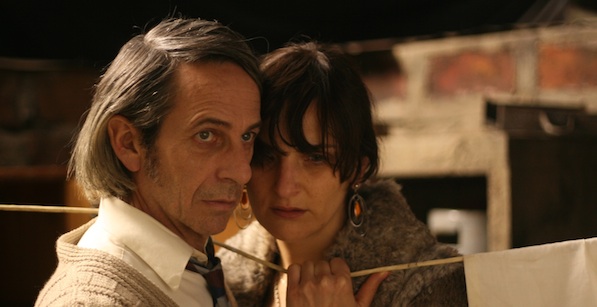Considering its wide functionality, cinema is perhaps the most well equipped medium to relate the intangible feeling of transience. The essentially absolute weight of the moving image, coupled with the dynamic possibilities of its employment, has resulted in countless articulations of yearning, elegiac ephemerality. From Terrence Malick’s symphonic waltzes to Andrei Tarkovsky’s grand confrontations with mortality to Aleksandr Sokurov’s grave evocations of apparitional communion to even Wong Kar-wai’s hallucinatory displays of emotional paralysis, there has been no lack of near-cosmic demonstrations of modern film’s ability to reflect transitory states of existence.
Chilean director Pablo Larraín is certainly not at the level of experience or expression of the aforementioned masters, but in his short career has arguably accomplished something just as notable. Over his last three films, Larraín’s engagement with the spiritual devolution of his country’s people at the hands of former dictator Augusto Pinochet has found him utilizing various narrative frameworks through which to visualize a nation’s disenchantment. The period settings—and in the case of his latest, No, the actual historical backdrop—of these films has understandably precipitated a temporal logic on behalf of Larraín. It is in his careful consideration of both the effects of the Pinochet regime on the people of Chile and the volatile temperament of the era, however, where his unblinking realization of a culture in transition is most deeply felt.
Each of these film’s reflect the implications of Pinochet’s reign in their own unique way, but it’s the final scene of 2010’s Post Mortem, the second and most devastating film in Larraín’s loosely defined trilogy, that most directly realizes the sense of psychological impermanence with which the filmmaker appears to be wrestling. A static, six-minute shot of man systematically trapping the object his affection and her lover inside a small shelter by piling debris in front of its door doesn’t, at first blush, seem a likely conduit for such a provocative representation of a country in the throes of decline. It’s Larraín’s attention to the personal ramifications of the era’s political practices, along with the aesthetic establishment of mood and the narrative organization of his characters’ everyday lives—in this case, the obsession a lonely morgue assistant named Mario (Alfredo Castro) develops for a local cabaret dancer (Antonia Zegers)—that creates a natural tension which ultimately begs for a relief that the director suggests may never arrive.
Far be it for me to speak too definitively about process, not being a filmmaker myself, but the degree of difficulty in effectively conveying a sense of both pregnant anticipation and, soon thereafter, fleeting hope seems especially pronounced when working in such a starkly realistic milieu. Without reasonable need to utilize the aesthetic resources which can help facilitate similar sentiments in more fantastical or, at the very least, operatic films, Larraín is left to coax genuine sensation from simpler tools. In Tony Manero, the first of his Pinochet-era films, it was through the specter of John Travolta’s Saturday Night Fever character, idolized and compartmentalized by Castro’s Raúl Peralta, another of Larraín’s lonely men, this time moonlighting as both a disco dancer and serial killer.
Watch this ‘Post Mortem’ scene.
Meanwhile, for Post Mortem, Larraín creates his own city of living dead, a zombified population conducting day-to-day activities as if in drowned in hypnosis (Mario, already of ghostly visage, grows paler as the film proceeds). When the nascent political turmoil erupts in a series of bombings and protestations, Mario attempts to help his effected love interest by hiding her from further harm beneath a housing complex. The build-up is methodical, Larraín’s patient depiction of events a source of both intrigue and discomfort. (No, for its part, takes a less allegorical approach, detailing the campaign to rally support of the referendum which would lead to Pinochet’s removal from office).
Post Mortem’s final shot, then, comes not as relief but painful reconciliation, offering not closure but the advancing revelation that these characters—and, by extension, the Chilean people—are caught in an age of flux, unable to escape the collateral consequence of the era’s political upheaval. And after a couple minutes, as the realization sets in that this is more than likely the conclusion of the film—the tension by this point wound up like a knot—an unnerving sense of repose cuts the anxiety like a knife even as we sit knowing Mario is far from satisfied. For six minutes we’re caught in an intermediary moment for an entire country, trapped by Larraín’s widescreen composition—growing more suffocating by the second as Mario stacks junk across the frame—nowhere to go, held breathless until one final cut to black.




